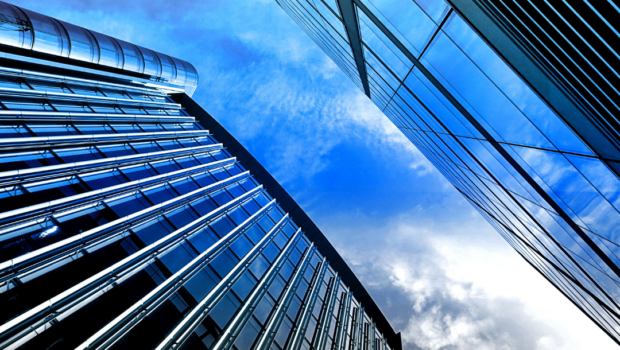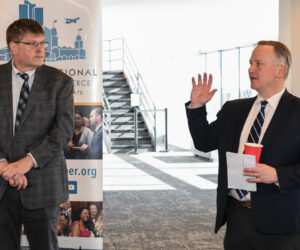By: Alex Guardiola, Vice President of Government Affairs and Public Policy and David Sullivan, Director of Economic Development and Business Recruitment
The Worcester Regional Chamber of Commerce is announcing its public support for adopting the Massachusetts specialized building energy code for an effective date of January 1, 2025.
The City of Worcester is ambitious when it comes to tackling climate change. The adoption of the Green Worcester Plan in 2021 as a blueprint to make Worcester the most sustainable and resilient mid-size city in America was a significant milestone. Now it is up to a diverse group of stakeholders in the city, including the business community, to work together on that goal.
The Massachusetts “specialized code” would be a significant step forward in preparing the city for the realities of climate change. The city is seeing, with increasing frequency, many of the effects of climate change that are happening around the globe, including rising average temperatures and increasing severe weather. This building energy code will set the stage to make the city’s buildings more resilient to the effects of climate change and reduce pollution over time.
Worcester is already a “stretch community” designated under the Massachusetts Green Communities Act of 2008, passed under the stewardship of Chamber President and CEO Tim Murray when he served as Lieutenant Governor with Governor Deval Patrick. Every few years, new stretch code regulations promulgated by the Department of Energy Resources (DOER) are automatically adopted by 300 communities in the Commonwealth who have opted into the stretch. DOER created the specialized code as a more energy efficient version of the stretch code that municipalities can choose to adopt.
The newest stretch code came into effect July 1 this year for commercial properties. The specialized code would go a step further in terms of energy efficiency and is designed to get Massachusetts closer to its stated goal of achieving net zero emissions by 2050.
The new stretch code automatically implemented several changes, mostly focused around improving the air tightness of new buildings to reduce heating and cooling usage, as well as pre-wiring newly constructed homes and multifamily buildings for electric vehicle (EV) charging and photovoltaics (PV), otherwise known as solar panels. New buildings under the stretch are not yet required to have certain amounts of EV charging stations and solar panels, but must be wired to accommodate future installation. New homes will now have at least one spot wired for future EV charging and have 40% of roof space prepared for PV installation. Additionally, multifamily developments now must have 20% of parking spaces pre-wired for EV charging. A significant change this year was applying the code to renovations of over 1,000 square feet, not just new construction. Historic properties remain exempt from this.
The specialized code would include all stretch requirements, but add new provisions such as requiring all new homes over 4,000 square feet to be all-electric, and all multifamily buildings over 12,000 square feet to achieve Passive House design standards which increase building costs by between 1 to 4% but reduce heating and cooling loads by up to 90%, according to Passive House Massachusetts. No new specialized code requirements would apply to renovations. To make the transition easier, there are pathways to specialized code compliance for mixed fuel buildings (meaning buildings still using gas).
The Chamber is cautious to support new regulations on small businesses and property owners, and we do not express this support without consideration of the consequences. We are proposing that the city council move to adopt the specialized code with an effective date of January 1, 2025 to give the city administration, developers, property owners, and residents the time necessary to prepare. DOER already advises that communities take 6-11 months after a vote of approval by a city council to work with the state on the process and prepare for the effective date.
Ultimately, we believe it to be a question of when, not if, the specialized code becomes the new stretch code, which is automatically adopted by the city. Worcester should still make a statement on its commitment to battling climate change by becoming the first community outside the Greater Boston Area to adopt the specialized code and get a head start on preparing for its implementation.
However, the city needs this transitional period of at least a year to ramp up the necessary infrastructure for electrifying the building stock. There are several limitations to implementing the specialized code that Worcester must overcome, and changes that already must take place to catch up on implementing the stretch code.
The city must, first of all, be able to enforce the code by training its building and fire department inspectors and having enough energy raters to verify that homes and buildings are meeting new HERS ratings and Passive House standards. Contractors need time to adjust to ordering and installing new energy-efficient components like heat pumps and meeting increased demand for their services. Another looming question is whether the grid has the capability to handle a transition to an increasingly electrified building stock – the city and National Grid need time to analyze.
Property owners and homeowners need time to understand the costs and what incentives are available through programs and organizations like Mass Save, National Grid, the new Massachusetts Community Climate Bank, and MassDevelopment’s Property Assessed Clean Energy financing program – which Worcester still needs to opt into via city council for any city property owners to access. These programs must be optimized so builders and developers can rely on them when making financial projections.
With construction costs at some of the highest levels in decades, and housing costs being similarly high, financial support is crucial to ensure that the cost of building is not shifted to the homeowner or the tenant. A recent report by MIT, the Wentworth Institute of Technology, and the Home Builders & Remodelers Association of MA warned that the new specialized code will increase housing construction costs by 1.8 to 3.8%, and that these costs have the potential to be shifted onto low-income renters and first-time homebuyers who would bear the greatest financial burden of decarbonization. For residential builders, developers, and property owners, there must be adequate time for a robust public information campaign about financing and incentives available to support code-compliant construction and minimize housing cost increases.
DOER contends that cost savings over time from reduced utilities usage balance out the upfront price tag and actually reduces construction costs in specific types of buildings. Regardless, every effort must be made to ensure property owners and builders have the resources they need to comply with the stretch code, as well as the specialized code.
The Chamber will continue to work with the city council, DOER and the state administration, the city manager’s administration, National Grid, and other partners to make sure our members and the community at large are well-informed of new changes to the building energy code and that changes are implemented in a manageable manner while also doing everything we can to address climate change. We look forward to a robust discussion about adopting the specialized code effective early 2025.
For questions, please contact David Sullivan, Director of Economic Development & Business Recruitment, and Alex Guardiola, Vice President of Government Affairs & Public Policy, at the Worcester Regional Chamber of Commerce.





